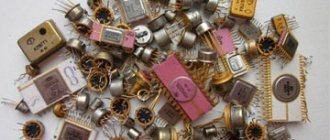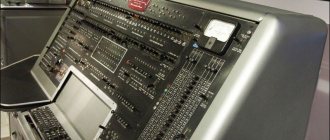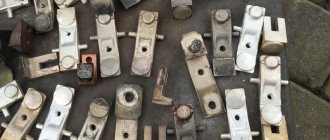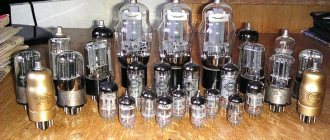May 08, 2021
In technology, gold is often used to cover contacts, slots, and connectors. Gold does not undergo oxidation or corrosion and is an excellent conductor. On average, there is no more than 2 grams inside one computer. gold. Depending on the model and year of manufacture, this figure may vary. On old computers, radio components with precious metals had a larger gram of gold and silver than on modern technology.
Despite the high cost of gold and silver, manufacturers still use these precious metals in radio components. Gold and other components provide high-quality deposition with a minimum coating thickness.
What precious metals are used in computers
In first place, of course, is gold. It has the highest resistance to oxidation and corrosion, but its electrical conductivity is lower than that of copper and silver.
The metal is soft, so it is not used in relay contacts. The main function of gold plating is to protect against contact with oxygen. That is why gold is used more than others in the production of equipment.
In second place is silver. It has better electrical and thermal conductivity than gold. Used when filling as a wire core or as a mirror surface to reflect light.
Platinum occupies third place in use. It has high anti-corrosion resistance and is used for high-precision equipment.
The fourth place is shared by metals such as palladium and ruthenium. Among other things, they provide heat resistance to radio components. It is inert to corrosion up to 900 degrees Celsius.
Demand for gold
Gold is one of the most inert metals. Under normal conditions, it does not interact with most acids and does not form oxides. This property has become in demand where metal destruction in the smallest parts cannot be allowed.
Gold is destroyed only by aqua regia, but in reality it is not very common, so this metal has found demand in electronics and medicine.
All mined gold that is in legal circulation is concentrated in:
- state and international financial organizations - 30,000 tons;
- jewelry items - 79,000 tons;
- products of the electronics industry and dentistry - 17,000 tons;
- investment savings - 24,000 tons.
If we consider that gold dentures are now giving way to ceramic dentures, then the turnover of gold in the electronics industry will not be so small.
Hard drive containing precious metals
The information storage device contained in the computer contains both silver (0.013 g) and gold (0.034 g). Compared to the motherboard, there is less precious metal, but it is also easy to detect. The deposition of precious metals on these parts is visible even with the naked eye.
Let us consider in detail radio components with precious metals in computers, with a minimum content of gold and silver. These are the processor pins on the LGA package that contain 2 mg. gold, PCI, PCIE 2 mg connectors. Precious metals are also used on the keyboard, fan, memory unit, and other components, however, they will contain a minimal amount there.
However, even if you collect all the components from one computer, you will receive 200 rubles worth of precious metals at market prices. The most “gold-bearing” ones are considered to be premium models of well-known brands. Manufacturers of such equipment use high quality raw materials and inflated costs.
The more modern the model, the less precious metal it contains.
Therefore, it is not worth disassembling a computer to collect precious metals, however, if there are 5-6 non-working system units, then disassembling and smelting will be profitable. ◄ Back to news
How much gold is contained in old type processors?
Old electronics from the 90s contain as much gold as 2 tons of ore in gold mines. In addition to gold, such a computer contains:
- platinum;
- silver;
- tantalum;
- palladium;
- ruthenium.
These rare earth metals can only be extracted from parts in an industrial setting, but gold from an old model computer can be extracted at home using a solution of hydrochloric acid and hydrogen peroxide.
It is also necessary to know in which parts this precious metal is present in its maximum size.
In general, in older desktop computers the gold content ranges from 4 to 12 g, while in modern models it does not exceed 35 mg due to the compactness of such hardware.
Legality of such mining
Expert opinion Vsevolod Kozlovsky 6 years in the jewelry business. Knows everything about samples and can identify a fake in 12 seconds. If you seriously decide to mine gold from old computer equipment, you should read the administrative code of the Russian Federation, since according to the law, all gold found in electronics belongs to the state.
The task of users, if equipment fails, is to dispose of it appropriately. Simply put, do not throw it in a landfill, polluting the environment, but hand it over to special collection points, which will then take the batch to a recycling plant:
- workers will manually disassemble and sort all the parts, which will then be sent for recycling;
- gold-containing parts will be crushed and refined.
You can do refining at home just for fun, since this process is quite exciting.
Mining process
There are several ways to extract precious metals from radio components. I'll tell you about the simplest ones. But in any case, first you should grind the gold-containing parts well. Separate metal from plastic as much as possible.
Option 1
Etching.
Place the crushed mass in a beaker with a solution of hydrochloric acid and hydrogen peroxide in a ratio of 1/3. Let me remind you that you need to pour peroxide into acid, and not vice versa. Don't forget about safety precautions and protective measures! Leave the solution for five to seven days.
Stir occasionally to speed up the reaction. Not all gold. And other metal should dissolve during this time. Next, the gold is filtered and melted.
Option 2
Actually refining.
The method is based on the ability of aqua regia (a mixture of hydrochloric and nitric acids in a ratio of 1/3) to dissolve gold.
So, we place the sorted and crushed parts in aqua regia. To speed up the process, the mixture can be warmed up a little. Don't forget about safety precautions! Once completely dissolved, gold can be recovered from solution. Available reducing agents are sodium pyrosulfite and ferrous sulfate. The reducing agent should be added little by little, since the reduction reaction proceeds with the release of gas.
After the gold has precipitated, we thoroughly wash it with water at least five times, wash it with alcohol, dry it and melt it with the addition of boric acid. The gold obtained in this way is of the highest standard.
What is valuable in LCD monitors. Throw it away or take it apart?
Hi all. Today is a new series of the column “Throw it away or take it apart?”, in which I take apart various devices and equipment and see what’s inside them. Of interest, first of all, is the presence of copper, as well as ferrous metal, aluminum, and brass. There are these monitors, one of which I’ll take apart.
The entire disassembly process takes about 10 minutes. The case is unscrewed and we see the contents - several small circuit boards and some hardware.
This part of the monitor is not picked up by a magnet, but it will not be accepted as stainless steel - it is sent to the ferrous metal.
A few more screws and the monitor is disassembled into parts and it is very easy to sum up the results of this disassembly, because... There is nothing special to evaluate and weigh - 300 grams of ferrous metal.
Several small boards weighing 200 grams. Starting this year, we started accepting payments in our city, all indiscriminately, at 50 rubles per kilogram, minus 10% clogging.
And here is the place where you can see a little copper, which when disassembled turns out to be 30 grams. We accept copper at 350 rubles per kilogram.
And quite a bit of aluminum, about 5 grams.
I disassembled the old monitor for scrap metal. How much did I earn?
I recently received a fairly old monitor for disassembly, dating back to 1997.
.
Anyone who has been familiar with my channel for a long time knows that I am interested in collecting gold-containing
radio components. Therefore, I search through friends and acquaintances for unnecessary electronics and disassemble them.
It is believed that the older the equipment, the more non-ferrous and precious metals it contains.
. I think so too. This is due, in my opinion, to the fact that as various technologies develop, electronics manufacturers find ways to use fewer and fewer valuable components, thereby increasingly reducing the cost of their products.
Therefore, I was extremely interested in how this old monitor works.
Today I disassembled it, extracted from it all the metals and components that, in my opinion, were valuable.
And he roughly calculated how much he could earn
if he handed over the metals contained in it to a scrap metal collection point.
Once, I watched a story about a plant where such electronics are processed. And the head of the workshop told the reporter which equipment was most profitable in processing, and which was the opposite. Least profitable
he just named
monitors
. Since most of its weight is made up of a useless glass picture tube.
So, let's start disassembling it and see everything with our own eyes.
After unscrewing the 4 bolts at the corners of the case, I removed the back cover. Since I had previously disassembled an old TV with a picture tube, I already had a good idea of what valuable things I would find there. The most expensive thing in a monitor is copper
. In the sense that there is quite a lot of it in terms of weight. And it will bring the most money when sold for scrap.
Most of the copper is contained in the stranded copper wire wrapped with electrical tape, which surrounds the kinescope. Or rather, there are two copper rings, large and small. The cross-section of these wires is quite large, and therefore the weight of this ring circuit is decent.
Which computer parts contain the most gold and how to extract it: 2 ways + is it legal
Author of the article Alexey Stepanov Reading time: 4 minutes AA
Good afternoon, dear readers! Today we will plunge into the atmosphere of the Klondike. At the end of the 18th century. California was gripped by a gold rush. People came from all over the world in pursuit of grains of the precious metal. Read this article and you can feel like you are in a gold mine without leaving your home. I'll tell you how you can get gold from a computer.
The gold rush was remembered for one interesting incident - while playing in a stream near his house, a twelve-year-old boy, Conrad Reed, found a massive yellowish cobblestone. And for a long time the family propped up the door of the house with a gold stone weighing 7 kg. And then the bar was sold for an impressive price - $3.
Amazingly, many of us act equally irrationally, throwing household appliances, old motherboards and chips into landfills.
What will it take to extract gold from the processor?
To extract precious metal from computer parts, you will need hydrochloric acid and hydrogen peroxide. With their help, you can remove gold plating from computer parts. Hydrochloric acid can be replaced with citric acid, as jewelers do today.
You will also need to prepare:
- rubber gloves for working with chemical solutions;
- respirator to protect against hydrochloric acid fumes;
- glass container;
- protective glasses;
- a plastic stick for stirring the prepared solution.
Depending on how much gold is in the computer, a certain amount of solution is prepared from hydrochloric acid and peroxide in a 2:1 ratio.
When preparing a solution, you need to pour hydrochloric acid into hydrogen peroxide, and not vice versa. In this case, during the diffusion of the compositions there will be no splash of acid from the vessel.
You need to prepare the working solution in a ventilated room, wearing protective equipment on your hands and face.
You need to pour hydrochloric acid into the peroxide slowly, stirring the solution with a plastic stick. The resulting composition should give a greenish tint.
Parts from the processor containing gold are placed in this solution and left for a week in a glass container. The solution needs to be stirred from time to time.
Within a week, the gold traces from the boards and contacts will come off the parts and settle at the bottom of the vessel in the form of small gold grains.
To extract gold from acid, it is necessary to filter the solution through a paper or cloth filter. The gold particles settled on it should not be touched with your hands, as it is too soft and can turn into dust.
The gold grains remaining on the filter should be washed off with vodka or alcohol into a test tube or glass container with a tight lid.
Prices for scrap circuit boards
Mix of different types of boards 80/20
1. No more than 20% of Monitors 2. On domestic boards, more than 75% of the element base must be in place Raw materials must be free of clogging
GSM boards from cellular stations with yellow tracks Batteries, batteries, metal parts, plastic fasteners, radiators, etc. must be removed.
Server boards
Server boards (wide yellow connectors, several sockets for processors) Batteries, batteries, metal parts, plastic fasteners, radiators, etc. must be removed.
The motherboard is “old” and from laptops
Motherboards for laptops and motherboards up to (and not including) the Pentium 4 generation Batteries, batteries, metal parts, plastic fasteners, radiators, etc. must be removed.
Motherboards after the Pentium 4 generation (including Pentium 4). Batteries, batteries, metal parts, plastic fasteners, radiators, etc. must be removed.
HDD cards from hard drives
Cards removed from computer hard drives, metal parts, plastic fasteners must be removed.
Video, network and sound cards
Video, audio and network cards (all cards with yellow slats for PC) No metal, plastic or aluminum heatsinks
Control boards from office equipment and imported devices Without metal, plastic and aluminum radiators
Rich control boards
Control boards from medical and complex imported devices with yellow connectors Without metal, plastic and aluminum radiators
Memory “yellow” with gold-plated edges
Memory yellow Without aluminum radiators
Memory “white” with silver edges
Memory white Without aluminum radiators
Monitor boards and any power boards Boards must be cleared of metal, plastic, and transformers.
Boards from Soviet household devices Without metal, plastic and aluminum radiators
Control boards for military and Soviet devices of the USSR Without metal, plastic and aluminum radiators
Connectors ShR, ShRG (USSR)
Connectors ШР, ШРГ from Soviet industrial and military devices Without wires
Gold connectors import
Gold-plated connectors removed from switching boards such as GSM
Ceramic processors Without aluminum heatsink
What is the disk in a hard drive made of?
But if there were really a lot of these precious metals... In fact, you need to use a lot of equipment to get several microcircuits and extract gold from them. Gold is extracted from microcircuits by dissolving them in acid, and gold is condensed from the resulting liquid, but you need quite a lot of microcircuits to extract just a few grams of expensive metal! The collapse of the USSR occurred in 1991. 17 years have passed since then, and the old equipment is becoming less and less available. The big machines were the first to be destroyed, and this is not accidental. I saw something like this on the Internet: large machines like the EU could contain about a kilogram of gold, or even more! But it was not only gold that attracted and continues to attract hunters—“metalworkers.” Many computers contained hundreds, if not thousands, of small green capacitors called capacitors. They were bitten off by everyone and anywhere possible in order to extract a few grams of palladium from them. But in order to get a few grams, you need to get a lot of capacitors and, of course, spoil a huge amount of equipment. And if there were no precious metals in the equipment, it was broken just like that! For example, motors for rewinding bobbins were used to make fans for house windows... All this is very similar to hammering nails with a microscope











